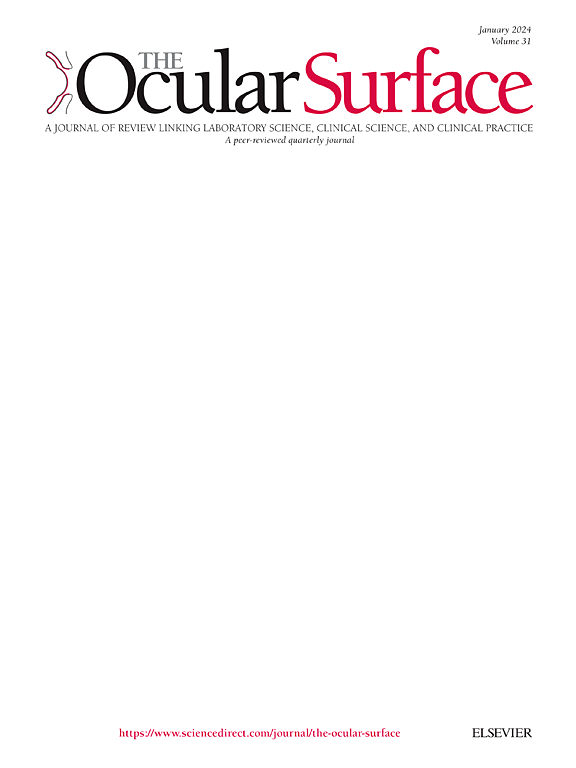Endoplasmic reticulum stress contributes to the development of ocular graft-vs-host disease in the eyelids and the ocular surface
IF 5.6
1区 医学
Q1 OPHTHALMOLOGY
引用次数: 0
Abstract
Background
While endoplasmic reticulum (ER) stress has been implicated in various aspects of graft-versus-host disease (GVHD), its effects on the eyelids and ocular surface in patients with chronic GVHD (cGVHD) remains poorly understood. We aimed to investigate the relationship between ER stress and ocular GVHD using the ER stress suppressor, 4-phenylbutyric acid (PBA).
Methods
The study used allogeneic bone marrow transplantation (BMT) and syngeneic BMT to establish a cGVHD mouse model. cGVHD mice were treated with either intraperitoneal administration of PBA or 2 % PBA eye drops following BMT.
Results
The Intraperitoneal PBA-treated (PBAip) group retained a larger meibomian gland (MG) area and corneal epithelial damage and inflammatory and fibrotic cell infiltration in the ocular surface was attenuated compared to vehicle-treated cGVHD mice. The expression of unfolded protein response markers was significantly elevated in the vehicle group compared to the syngeneic control and the PBAip group. Electron microscopy and immunohistochemistry revealed that fibroblasts and macrophages infiltrated the eyelids and ocular surface of cGVHD mice under ER stress. The corneal fluorescein staining score was significantly lower in the PBA eye drop-treated group than in the vehicle-treated group. The numbers of leukocyte marker CD45-, T cell marker CD4-, and macrophage marker F4/80-positive cells were significantly reduced in the PBA eye drop-treated group compared to the vehicle group.
Conclusions
The study suggests that the ER stress response, which is triggered by cGVHD in ocular surface tissues, can be suppressed by PBA, an ER stress suppressor, potentially offering therapeutic benefits in ocular GVHD.
内质网应激有助于眼睑和眼表眼部移植物抗宿主病的发展。
背景:虽然内质网(ER)应激与移植物抗宿主病(GVHD)的各个方面有关,但其对慢性移植物抗宿主病(cGVHD)患者眼睑和眼表的影响仍知之甚少。我们的目的是通过内质网应激抑制剂4-苯基丁酸(PBA)来研究内质网应激与眼GVHD之间的关系。方法:采用同种异体骨髓移植(BMT)和同基因骨髓移植(BMT)建立cGVHD小鼠模型。cGVHD小鼠在BMT后分别腹腔注射PBA或2% PBA滴眼液。结果:腹腔注射pbap组小鼠的睑板腺(MG)面积较大,角膜上皮损伤和眼表炎症、纤维化细胞浸润均明显减轻。与同基因对照组和PBAip组相比,载药组未折叠蛋白反应标志物的表达显著升高。电镜和免疫组织化学显示,内质网应激下,成纤维细胞和巨噬细胞浸润到cGVHD小鼠的眼睑和眼表。PBA滴眼液治疗组角膜荧光素染色评分明显低于载药治疗组。PBA滴眼液治疗组白细胞标记物CD45-、T细胞标记物CD4-、巨噬细胞标记物f4 /80阳性细胞数量较对照药组明显减少。结论:本研究提示,由cGVHD在眼睑引发的内质网应激反应可以被内质网应激抑制因子PBA抑制,这可能为眼部GVHD的治疗提供益处。
本文章由计算机程序翻译,如有差异,请以英文原文为准。
求助全文
约1分钟内获得全文
求助全文
来源期刊

Ocular Surface
医学-眼科学
CiteScore
11.60
自引率
14.10%
发文量
97
审稿时长
39 days
期刊介绍:
The Ocular Surface, a quarterly, a peer-reviewed journal, is an authoritative resource that integrates and interprets major findings in diverse fields related to the ocular surface, including ophthalmology, optometry, genetics, molecular biology, pharmacology, immunology, infectious disease, and epidemiology. Its critical review articles cover the most current knowledge on medical and surgical management of ocular surface pathology, new understandings of ocular surface physiology, the meaning of recent discoveries on how the ocular surface responds to injury and disease, and updates on drug and device development. The journal also publishes select original research reports and articles describing cutting-edge techniques and technology in the field.
Benefits to authors
We also provide many author benefits, such as free PDFs, a liberal copyright policy, special discounts on Elsevier publications and much more. Please click here for more information on our author services.
Please see our Guide for Authors for information on article submission. If you require any further information or help, please visit our Support Center
 求助内容:
求助内容: 应助结果提醒方式:
应助结果提醒方式:


